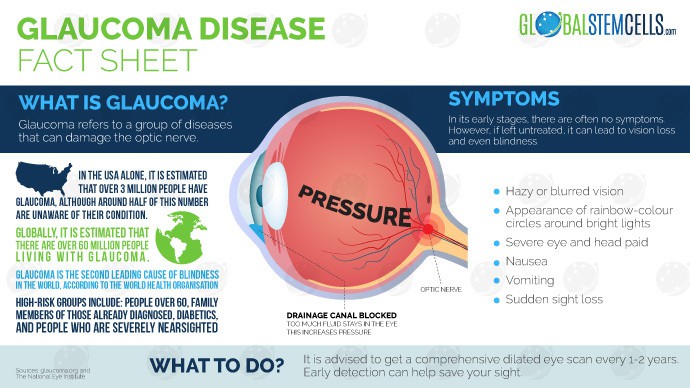Glaucoma is an eye condition that causes damage to the eye’s optic nerve leading to poor vision.
There is no definitive cure for Glaucoma and Glaucoma-related vision loss cannot be restored.
However, early detection and treatment can delay progression of the disease and prevent complete loss of vision.
Available treatment options include medication and surgery.
Causes of Glaucoma
Doctors have linked Glaucoma to pressure build up inside the eye – intra-ocular pressure. The increased intra-ocular pressure can damage the nerve that sends image signals to the brain. Continued damage to the nerve can lead to permanent blindness if not detected and treated early.
Glaucoma Symptoms
In its early stages, Glaucoma has no symptoms and causes no pain. The vision stays normal making its early detection all the more difficult. As the disease progresses, the patients will slowly begin to lose their peripheral vision. The patients easily miss objects on their sides or out of the corner if their eyes. If it remains untreated, Glaucoma leads to decreased central vision until the patients can no longer see.
Stem Cell Derived Exosomes
A new study on stem cell exosomes, by researchers at the National Eye Institute, has shown promise for treatment of Glaucoma. Using the stem cell secretions from Mesenchymal Stem Cells (MSC), the scientists were able to prevent further degeneration of the retinal ganglion cells.
Exosomes are extracellular vesicles that are secreted by cells after fusion of the multi-vesicular body with the plasma membrane. Exosomes secreted by Mesenchymal Stem Cells contain messenger RNA and microRNA proteins which can migrate to nearby cells when the exosomes fuse with the target cell’s membrane.
The study, published in the journal Stem Cell Translational Medicine, investigated the role of exosomes Bone-Marrow Derived Mesenchymal Stem Cells (BMSC) on retinal ganglion cells. The team led by Ben Mead studied the effects of the stem cell secretion on rats that had their optic nerve damaged.
They injected fluorescent stained exosomes into the rodent’s vitreous on a weekly basis. The fluorescent marker helped the scientists monitor the exosomes and track delivery of the cargo to the retinal ganglion cells. After 21 days, the treated rats lost about a third of their retinal ganglion cells compared with a ninety percent loss among untreated rats.
The microRNA molecules found in the exosomes were reported to interfere with or silence gene expression hence the positive results. According to Stanislav Tomarev, a principal investigator in the study, more studies required to further understand the specific contents of exosomes that make them effective. In his own words: “We need to know which particular microRNA – there are more than 2000 different microRNA molecules – are delivered into the retinal ganglion cells and what proteins or signaling pathways are being targeted upon arrival.”
The Potential of Exosomes
The main advantage of using exosomes serried form stem cells over using entire stem cells is that exosomes can be “purified, stored, and precisely dosed” unlike entire stem cells. Secondly, the body’s immune system cannot reject exosomes and the risk of unwanted cell growth is averted.
BMSC derived exosomes have created new possibilities for treatment of Glaucoma and other degenerative eye diseases.
If you have any questions about stem cell treatment for Glaucoma, please contact us or click here to learn about our patient Roland, and this recent treatment.
H/T: Medical News Today





 English
English